Functional genomics in Brugia malayi reveal diverse muscle nAChRs and differences between cholinergic anthelmintics
- PMID: 28487481
- PMCID: PMC5448196
- DOI: 10.1073/pnas.1619820114
Functional genomics in Brugia malayi reveal diverse muscle nAChRs and differences between cholinergic anthelmintics
Abstract
Many techniques for studying functional genomics of important target sites of anthelmintics have been restricted to Caenorhabditis elegans because they have failed when applied to animal parasites. To overcome these limitations, we have focused our research on the human nematode parasite Brugia malayi, which causes elephantiasis. Here, we combine single-cell PCR, whole muscle cell patch clamp, motility phenotyping (Worminator), and dsRNA for RNAi for functional genomic studies that have revealed, in vivo, four different muscle nAChRs (M-, L-, P-, and N-). The cholinergic anthelmintics had different selectivities for these receptors. We show that motility and patch-clamp responses to levamisole and pyrantel, but not morantel or nicotine, require the unc-38 and/or unc-29 genes. Derquantel behaved as a competitive antagonist and distinguished M-nAChRs activated by morantel (Kb 13.9 nM), P-nAChRs activated by pyrantel (Kb 126 nM), and L-nAChRs activated by levamisole (Kb 0.96 µM) and bephenium. Derquantel was a noncompetitive antagonist of nicotine, revealing N-type nAChRs. The presence of four diverse nAChRs on muscle is perhaps surprising and not predicted from the C. elegans model. The diverse nAChRs represent distinguishable drug targets with different functions: Knockdown of unc-38+unc-29 (L- and/or P-receptors) inhibited motility but knockdown of acr-16+acr-26 (M- and/or N-receptors) did not.
Keywords: Brugia; dsRNA; filaria; nAChR; patch clamp.
Conflict of interest statement
The authors declare no conflict of interest.
Figures

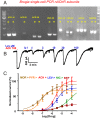
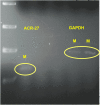
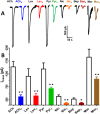
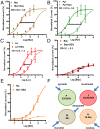
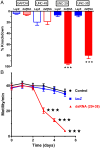

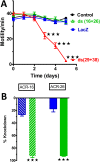


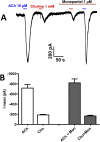
Similar articles
-
Whole-cell patch-clamp recording of nicotinic acetylcholine receptors in adult Brugia malayi muscle.Parasitol Int. 2013 Dec;62(6):616-8. doi: 10.1016/j.parint.2013.03.008. Epub 2013 Apr 3. Parasitol Int. 2013. PMID: 23562945 Free PMC article.
-
Investigation of acetylcholine receptor diversity in a nematode parasite leads to characterization of tribendimidine- and derquantel-sensitive nAChRs.PLoS Pathog. 2014 Jan 30;10(1):e1003870. doi: 10.1371/journal.ppat.1003870. eCollection 2014 Jan. PLoS Pathog. 2014. PMID: 24497826 Free PMC article.
-
The nicotinic acetylcholine receptors of the parasitic nematode Ascaris suum: formation of two distinct drug targets by varying the relative expression levels of two subunits.PLoS Pathog. 2009 Jul;5(7):e1000517. doi: 10.1371/journal.ppat.1000517. Epub 2009 Jul 17. PLoS Pathog. 2009. PMID: 19609360 Free PMC article.
-
Contributions from Caenorhabditis elegans functional genetics to antiparasitic drug target identification and validation: nicotinic acetylcholine receptors, a case study.Int J Parasitol. 2006 May 31;36(6):617-24. doi: 10.1016/j.ijpara.2006.01.016. Epub 2006 Mar 6. Int J Parasitol. 2006. PMID: 16620825 Review.
-
Drug resistance and neurotransmitter receptors of nematodes: recent studies on the mode of action of levamisole.Parasitology. 2005;131 Suppl:S71-84. doi: 10.1017/S0031182005008668. Parasitology. 2005. PMID: 16569294 Review.
Cited by
-
Diethylcarbamazine mediated potentiation of emodepside induced paralysis requires TRP-2 in adult Brugia malayi.Int J Parasitol Drugs Drug Resist. 2022 Dec;20:108-112. doi: 10.1016/j.ijpddr.2022.10.002. Epub 2022 Oct 29. Int J Parasitol Drugs Drug Resist. 2022. PMID: 36368250 Free PMC article.
-
Expression and Secretion of Circular RNAs in the Parasitic Nematode, Ascaris suum.Front Genet. 2022 May 31;13:884052. doi: 10.3389/fgene.2022.884052. eCollection 2022. Front Genet. 2022. PMID: 35711944 Free PMC article.
-
Diethylcarbamazine elicits Ca2+ signals through TRP-2 channels that are potentiated by emodepside in Brugia malayi muscles.Antimicrob Agents Chemother. 2023 Oct 18;67(10):e0041923. doi: 10.1128/aac.00419-23. Epub 2023 Sep 20. Antimicrob Agents Chemother. 2023. PMID: 37728916 Free PMC article.
-
Advances in Omic Studies Drive Discoveries in the Biology of Anisakid Nematodes.Genes (Basel). 2020 Jul 15;11(7):801. doi: 10.3390/genes11070801. Genes (Basel). 2020. PMID: 32679891 Free PMC article. Review.
-
Human Migration and the Spread of the Nematode Parasite Wuchereria bancrofti.Mol Biol Evol. 2019 Sep 1;36(9):1931-1941. doi: 10.1093/molbev/msz116. Mol Biol Evol. 2019. PMID: 31077328 Free PMC article.
References
Publication types
MeSH terms
Substances
Grants and funding
LinkOut - more resources
Full Text Sources
Other Literature Sources

